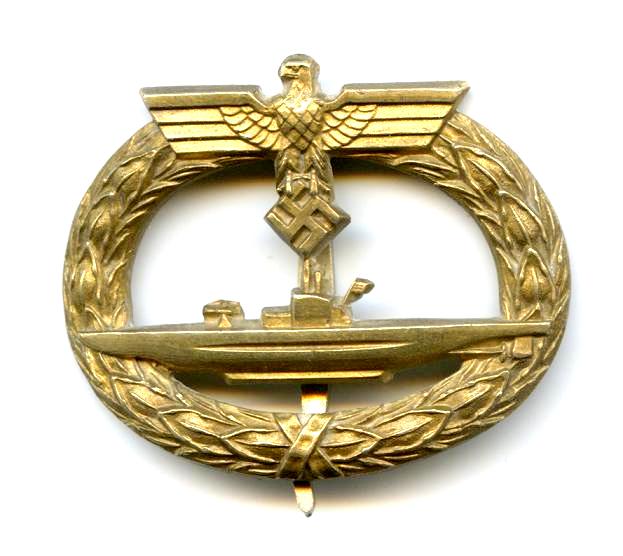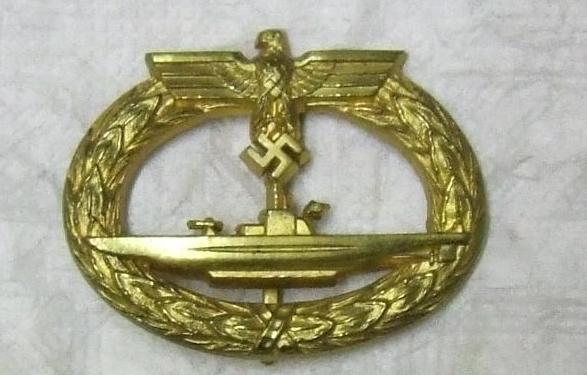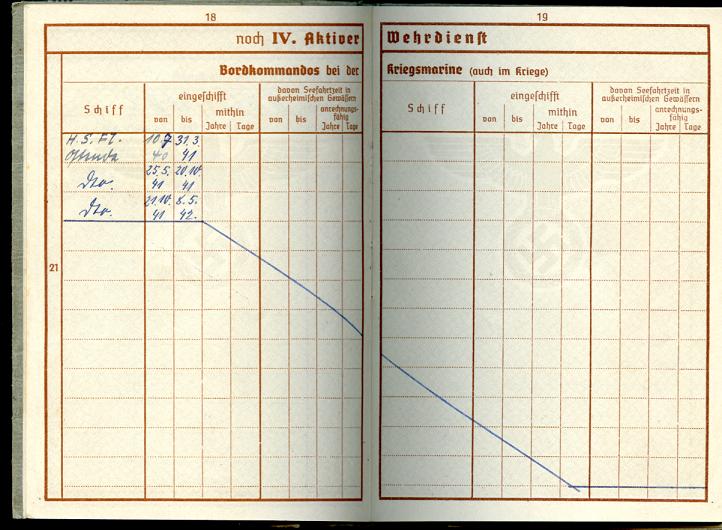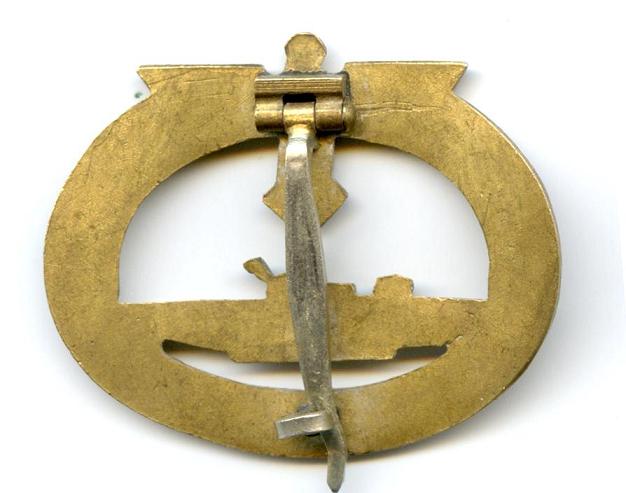-
Posts
5,391 -
Joined
-
Last visited
-
Days Won
3
Content Type
Profiles
Forums
Blogs
Gallery
Events
Store
Posts posted by Gordon Williamson
-
-
-
...arrived today. Nice character piece which had been hand vaulted by its owner.
Only thing better than getting a nice Juncker is getting it from a dealer at around half the price it should have been :cheers:
 0
0 -
Some tallies which I have , unfortunately not all are full length.
You have some super tallies there James, the Admiral Hipper is a real beauty !
0 -
For me at least.
Its an early Juncker of course but not any run of the mill Juncker.
This mint piece (sadly this snapshot doesn't do it justice) has all its original gilding and note that the swastika is cut out, as is the area around the deck gun. A superlative badge, and one which belonged to Korvettenkapitän Hans Müller of U-14, and was recently donated to the collection of the Deutsches U-Boot Museum.
They don't come any better than this. <img src="http://gmic.co.uk/public/style_emoticons/<#EMO_DIR#>/love.gif" style="vertical-align:middle" emoid="
 " border="0" alt="love.gif" />
" border="0" alt="love.gif" /> 0
0 -
As copies go, its one of the better ones and a good "space filler". I've seen this type being offered as real on a couple of occasions by big name dealers.
0 -
You'd need much sharper images to have a chance of being certain. One thing I don't like is the colour. It has that very "yellow" look that modern copies have instead of the more golden yellow colour of originals.
0 -
Not original I'm afraid. The central wreath is too "flat" and the arms connecting the suspension loop to the arms should be tapered, not parallel.
0 -
<!--quoteo(post=355456:date=Jul 14 2009, 17:39 :name=Rick Research)--><div class='quotetop'>QUOTE (Rick Research @ Jul 14 2009, 17:39 ) <a href="index.php?act=findpost&pid=355456"><{POST_SNAPBACK}></a></div><div class='quotemain'><!--quotec-->It does seem quite a come down/waste of trained talent for the 2nd officer of an ocean liner to have been skippering a small harbor boat 2 1/2 years into the war.<!--QuoteEnd--></div><!--QuoteEEnd-->
Happened more often than you'd think. My old friend ( now sadly deceased) Otto Giese was a Merchant navy officer on the Anneliese Essberger. He <u>did</u> get the Blockade Breaker badge but when he later volunteered to transfer to the Kriegsmarine he had to start at the bottom again as a seaman. He was eventually commissioned into the KM and became Watch Officer on U-181 under Wolfgang Lüth.
Even though they were highly qualified, Merchant navy officers would not normally be transferred into the KM without reverting in rank and "proving" themselves again. Many of the top men in the KM were former Merchant Navy officers though ( like Günther Prien)
0 -
With further research all begins to become clear. He was no normal conscript but a highly experienced Merchant Seaman ( hence driving licence photo in blue reefer jacket). He had served aboard the sail training ship Grossherzogin Elisabeth, then on various merchant ships as an ordinary seaman, specifically the Norddeustche Lloyd line vessels Elberfeld , and Lahn , gaining his "Steuermann" ticket in 1930. He then served as 4th Officer with the Hamburg Südamerika Linie on the Cap Norte and Pernambuco , then back to Norddeutsche Lloyd serving on Isar again as 4th Officer.
In 1932 he attended ship's captain school in Weserm?nde and got his captains "ticket" in July 1933.
Subseuqnetly he travelled the world, again mostly with Norddeutsche Lloyd line, on Columbus, Sierra Cortdoba, Oratara, Europa, Scharnhorst and Eider.
Joining the Kriegsmarine he was posted to the Harbour Defence Flotilla in Ostend as a Sonderf?hrer with the nominal rank of Steuermann and was "Führer der Hafenschutzgruppe Ostend"
Most Merchant Navy officers who transferred to the KM had to "start again" and spend some time in the ranks. This guy was nominated as "ROA" or "Reserve Offizieranwärter" and so would ultimately have been comissioned had he survived.
The group of boats he commanded were former fishing boats to which flak guns (usually light 2cm or at most 3.7cm) had been added and provided escort to ships passing in and out of port.
His boat was attack by RAF aircraft during an attack on the port and he and some of his crew killed.
Can't find anything so far relating to RAF bomber command aircraft attacking Ostend on that date so it was most likely a fighter unit strafing the port facilities.
The interesting thing is that during the first few months of 1942, volunteer US pilots from the famed "Eagle Squadrons" were extensively
used on fighter sweeps agains ports including Ostend, so Wode may have been killed by an American rather than British pilot.
Just shows what a great little research project can be had from a modest little grouping at a very reasonable price!
0 -
Obituary. Note he is listed as the "Kommandant" of a boat.
 0
0 -
Condolence letter to his N.O.K. from his unit commander.
The letter mentions him being buried with full military honours.
 0
0 -
Wehrpass shows him killed in action on 8 May 1942
"Am 8, Mai 1942 auf einem Hafenschutzboot gefallen"
 0
0 -
He served with Hafenschutzflotille Ostend, where there was a major E-Boat base, using huge concrete bunkers similar to U-Boat bunkers.
 0
0 -
Came with his driving licence and dog tag.
Interesting thing is that he appears to be wearing a blue reefer jacket in this 1938 licence and has his name on the dog tag. He didn't join the Navy until 1940 and he was a JNCO, usually only officers names were on the dog-tag which for lower ranks just had their number.

 0
0 -
This Wehrpass was to a junior NCO rank who was KIA in May 1942.
 0
0 -
Generally reddish brown but I think I recall seeing one in a greenish colour one time. I think its the material rather than the colour itself that is significant.
0 -
A better shot of mine
 0
0 -
Looks like it could be OK. Really need to see the letter "K" which is cropped off in the pic. There is an error in the "K" on the modern fakes in that the "hole" if you can call it that, in the upper part of the K is too small.
You can see my original in this thread.
0 -
He retired-- so that lets him out as a suspect.

And the answer is---------------- Konteradmiral Heinz-Eduard Menche, chief of Kriegsmarine Dienstelle Bordeaux Jan 41 - Apr 43, then chief of Kriegsmarine Dienststelle Marseille May 43 - Jul 44. :D
0 -
Wonderful restoration job. It looks magnificent now !
0 -
If we look at the ships (Light Cruiser and above) whose crews would qualify for the fleet badge and then take the crew numbers, it gives us a start point of nearly 23,000.
Bismarck 2092
Tirpitz 2608
Gneisenau 1840
Scharnhorst 1840
Graf Spee 1150
Admiral Scheer 1150
Deutschland 951
Bl?cher 1600
Hipper 1600
Prinz Eugen 1600
Schlesien 802
Schleswig Holstein 802
Emden 683
K?nigsberg 850
Karlsruhe 850
K?ln 850
Leipzig 850
Nurnberg 850
22968
Factor in that crews rotated from other ships i.e. someone moving from a Destroyer then on to a Battleship then on to U-Boats etc then those who moved on had to be replaced. So, for a ship with say a crew of 850, then over a period of time the actual number of men sho served on that ship over the period of the war could easily be three times that number. Not all would complete the requisite number of missions for the badge of course, but I'd say the typical crew compliment would represent the base minimum number of sailors who served on that ship over time and qualified for the badge.
On the other hand some ships, like Graf Spee were sunk even before the Fleet Badge was introduced BUT, Graf Spee crew members are known to have received the Fleet Badge some time later as a commemorative piece.
So, I would say that the approximately 23,000 number would be a conservative figure. Factor in also the fact that some sailors would have had two or even three examples of the badge (I have seen this in donations to the U-Boat Archiv from former sailors who often donated the two or three examples of the badge that they owned).
So, we could easily be talking of around 50,000 badges. Quite a large number and certainly enough to warrant needing several manufacturing firms to keep up with demand.
0 -
Maybe I'm just not clear on the question, but all makers used a concave reverse on the Fleet Badge, including RSS. Foerster & Barth had a particularly deply indented reverse face. Never seen a genuine flat backed one, though some are more concaved than others.
Only the obverse deisgns were specified in the original foundation orders, so whether a badge ended up with a concave reverse like the Fleet Badge or a flat back like the Marine Artillery was most likely decided for technical reasons by the guys responsible to creating the tooling.
0 -
IMO a genuine original wartime made piece, but just in very poor condition. What I specifically like is the way the reverse finish is flaking away from the underlying base metal in places on the reverse.
I recently had a very early first type Scherin Destroyer in Tombak which was ground dug and the degredation to the finish matched this almost exactly.
 0
0 -
Material would certainly help dictate the likely identity of the manufacturer.
If Zinc it is probably either late 1st type Mayer ( we have absolutelty no way of knowing when the Mayer changed over to the second type so cannot rule out a first type min Zinc) or variant Zimmermann. Mayer by far the most likely IMO.
If Buntmetall it is probably either Schickle or Mayer as Zimmermann in Buntmetall would almosty certainly have all arms of the swas cut out.
Of the two this type of hinge fitting has never, to my knowledge at least, been seen on a verified Schickle badge (which is so far only known with either a needle pin or the "EK" type pin with an L/15 mark). So, again, Mayer is most likely.
Seems like whatever the material Mayer is the only likely maker ( given that there is no other known maker who used this design other than Schickle, Mayer and Zimmermann).
0





Unmarked Minesweeper
in Germany: Third Reich: Wehrmacht Medals, Decorations & Awards
Posted
My first thought too, but when I compared with two known F&B pieces I can see a few differences. Here are two F&B pieces, one early in Tombak and one later in Zinc.
Note the area to both badges around the eagles head is full cut out, compre the same area in Stewy's.